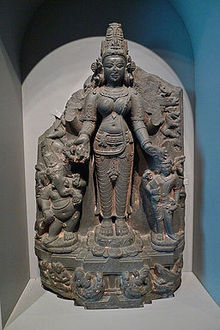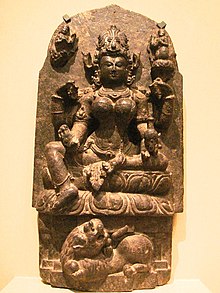Parvati


Parvati ( Sanskrit , f., पार्वती, Pārvatī) is a Hindu mother goddess who is considered the wife and Shakti of Shiva and mother of Ganesha and Skanda (also called Murugan or Karttikeya ). She is the daughter of Himavat , the god of the Himalayan mountains, and the Apsara Mena (also called Menga ) as well as the younger sister of the Ganga , the divine embodiment of the Ganges . Her name means "daughter of the mountains" (Skt .: parvata ). Parvati embodies the faithful, patient, devoted, loving, lovely, ideal and obedient wife. She is the personification of husband and mother love. She is the gracious, maternal, kind, gentle, caring, bright, loving and kind aspect of the Mahadevi , the "great goddess". Together with her husband Shiva and her son Ganesha, she forms the perfect example and role model of an ideal Hindu family. Parvati has many different manifestations, including Durga and Kali .
myth
In Vedic literature , a woman named Parvati does not appear in the vicinity of Rudra- Shiva; instead there are names like Uma , Sati or Ambika , which were only associated with or equated with Parvati in a later phase.
The Puranas present Shiva and Parvati as the parents of the universe and therefore contain many different myths related to their married life. Legend has it that one day Parvati met a beautiful ascetic in the mountains who was mourning his first wife, Sati . Parvati did not know that she herself was a reincarnation of Sati and recognized in the ascetic the god Shiva, with whom she fell in love. In order to become like him, she also began to lead an ascetic life and, for example, stood on one leg in a river for 1000 years until the god appeared before her as a wandering beggar. He put her to the test and wanted to seduce her. Parvati became very angry, whereupon Shiva showed himself in his true form. Both married. They then retired to Mount Kailash and began the sexual act, which went on for a long time. This act is said to have been so intense that the cosmos was shaken by it and the gods became afraid. The gods interrupted the love game between the two, and Shiva's seed fell into the Ganges , from which Karttikeya was born, who then saved the world from the demon Taraka . In other legends, Shiva alone had six children, but Parvati loved these children so much that one day she pressed them too hard and thus merged them into a child with six heads; thereby she also became the mother of Karttikeya. According to another version of the legend, she loved Karttikeya so much that milk began to run when she saw the divine child.
In the myth about the other son Ganesha, on the other hand, the best-known version is the one in which Parvati creates her son on his own, without the assistance of her husband Shiva. She needed a guardian for her bath and for this purpose she modeled Ganesha from her abraded body scabs, dirt, sweat and blood from her body, which she mixed with ointments, oils and Ganges water and brought to life with mantras .
Many myths say that Parvati feels abandoned by the ascetic Shiva and therefore feels lonely. Therefore she instigates the love god Kama to shoot a love arrow at Shiva. He notices the ruse and burns the god to ashes. Parvati later asks Shiva to bring the god back to life.
Once Parvati covered Shiva's eyes with a prank. Immediately the world went dark and Shiva grew a third eye on his forehead, with which he accidentally burned the forests of the Himalayas. Parvati was very sad about this and asked Shiva to restore the forests.
Another myth tells how Shiva was dissatisfied with her black body color and annoyed her with it. Parvati then practiced asceticism until Brahma granted her the desire to wear a light body color. From then on she called herself Gauri ("the blonde, golden, light, shiny, white"). Kali is said to have arisen from the discarded black color or skin, which according to other versions arose from her anger.
It is Parvati who makes Shiva a responsible husband and wife, housekeeper and family man and who at times tears him out of his deep meditation. Shiva and Parvati generally lead a harmonious, undisturbed, peaceful family life, with the exception of small quarrels and mutual abuse, which, however, do not last long. They often play a game of dice together, in which Shiva loses his beloved loincloth and Parvati initially resents it, whereupon she laughs at him. Once she is said to have disobeyed him, whereupon he turned her into a fisherman's wife and sent her to the people. After a while he turned himself into a fisherman, won Parvati back and forgave her.
iconography
In medieval sculptures Parvati appears sometimes sitting, sometimes standing, with two or four arms but always with bare breasts and surrounded by heavenly beings, servants and / or their sons Ganesha and Skanda / Karttikeya . Her mount alone is a tiger or a lion; she often sits or rides a bull ( nandi ) with Shiva . Especially in South India, the representation as a family is common with Shiva and Skanda (compare Somaskanda ).
In modern paintings and art prints, however, Parvati often appears together with Shiva as a graceful, fully clothed, richly adorned woman with two arms, a blue lotus flower in her right hand. When Parvati is shown individually, she sometimes has four hands, two of which hold a red and a blue closed lotus flower and the other two show the grace-granting hand gesture Varada mudra and the protection-granting Abhaya mudra . She often bears the same emblems as Shiva, such as the trident ( trishula ), the prayer chain ( mala ) or the cobra snake ( naga ). Like this one, she sometimes has a third, energetic eye on the middle of the forehead.
In her motherly aspect, she carries her son Ganesha in her arms in many depictions. Representations with Shiva, Parvati, Ganesha and Skanda as the 'Holy Family' on Mount Kailash are popular . Mostly their mounts ( vahanas ) are tigers or lions. It can be distinguished from Lakshmi by the lack of the characteristic chest band.
Often, however, it is also represented in aniconical form, in the form of a yoni ("mother's womb, origin, source"), which has the highly abstracted form of a female vulva , usually it encloses a lingam , the phallic symbol of her husband Shiva (compare in in this context also the legend about the ascetic Bhringi ).
The asteroid of the main inner belt (2847) Parvati is named after her.
meaning
Like Shiva, Parvati has the dual aspect of preservation and destruction. Mainly, however, she embodies the symbol of the life-giving and life-sustaining mother. Other of their names are Amba or Ambika ("mother"), Bhagavati ("sublime") or Jagadamba ("world mother"). As a Parvati, she is never portrayed angry. If, on the other hand, it embodies the aspect of destruction, it is called Kali or Durga . In Shaktism it is the embodiment of divine energy, the Shakti , without which the God Shiva, who is at rest in himself, could not fulfill his function. The scriptures use a series of images and metaphors to illustrate the complementary identity of Shiva and Shakti. So Shiva is the sky, Parvati the earth, Shiva the subject, Parvati the object, Shiva the sun, Parvati the light.
The iconography therefore shows both in a single figure as Ardhanarishvara , half male, half female, with Parvati always forming the left (= female) and Shiva the right (= male) side.
Adoration
The in various forms, e.g. B. as mountain goddess Gauri , (= "the whitish one"), as Uma (= "the gracious") or Annapurna (= "rich in food"), appearing goddess Parvati, only a few temples in India are consecrated (e.g. on Parvati Hill near Pune ). More often she is worshiped as Kali or Durga and of course as Shakti Shiva's wife .
See also
- Aparna (daughter of Mena and Himavat, god of snow and the Himalayas)
Mountains of the Himalayas, named after her or her aspects:
literature
- Harsha V. Dehejia: Parvati: Goddess of Love. Mapin Publishing, Ahmedabad 1999, ISBN 81-85822-59-X (English).
- Joe Heydecker : The Sisters of Venus: The Woman in Myths and Religions. Heyne, Munich 1994, ISBN 3-453-07824-1 .
- Anneliese and Peter Keilhauer: The imagery of Hinduism: The Indian gods and their symbolism. DuMont, 1983, ISBN 3-7701-1347-0 .
- David Kinsley: Indian Goddesses: Female Deities in Hinduism. Insel, Frankfurt / M. 1990, ISBN 3-458-16118-X .
- Article: Parvati. In: Rachel Storm: Encyclopedia of Eastern Mythology. Edition XXL, Reichelsheim 2000, ISBN 3-89736-305-4 .
Web links
Individual evidence
- ↑ for the following in essence: Parvati. In: Rachel Storm: Encyclopedia of Eastern Mythology. Edition XXL, Reichelsheim 2000, ISBN 3-89736-305-4 .
- ↑ David Kinsley: Indian Goddesses. Female deities in Hinduism. Insel-Verlag, Frankfurt am Main 1990, ISBN 3-458-16118-X , p. 58ff.
- ^ Lutz D. Schmadel : Dictionary of Minor Planet Names . Fifth Revised and Enlarged Edition. Ed .: Lutz D. Schmadel. 5th edition. Springer Verlag , Berlin , Heidelberg 2003, ISBN 978-3-540-29925-7 , pp. 186 (English, 992 pp., Link.springer.com [ONLINE; accessed on September 18, 2019] Original title: Dictionary of Minor Planet Names . First edition: Springer Verlag, Berlin, Heidelberg 1992): “1959 CC 1 . Discovered 1959 Feb. 1 at the Lowell Observatory at Flagstaff. "


